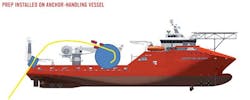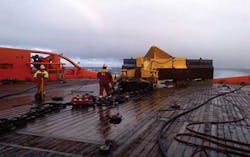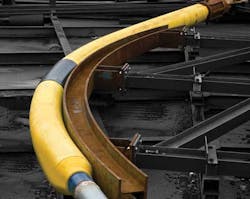Subsea oil and gas technology is continuously advancing to meet the requirements of increasingly demanding production environments: deeper water, greater distances from shore, higher reservoir temperatures and pressures. But sometimes progress comes in the form of smaller improvements or adaptations to already used methods. This article examines three such advances.
PREP
A rigid pipelay system which can be deployed from smaller, more readily available vessels will slash schedules and installation costs for pipe-laying projects, according to its maker Ecosse Subsea. Rigid pipelay projects typically rely on dedicated pipelay vessels commanding £250,000/day or more, the company said.
Ecosse Subsea's Plastic Reeled Elastic Pipelay (PREP) system is a modular system for laying reeled rigid pipe of up to 8-in. OD on a project-by-project basis in as much as 150 m of water from smaller vessels. System installation requires fewer than 48 hr.
PREP uses many of the same parts as a conventional pipelay system, but its component assembly avoids the need for it to be mounted on a specialist pipelay vessel, offering flexibility, mobility, and reduced cost. The PREP system uses steel pipe's elastic properties to lay pipe from smaller vessels without the fleeting tower dominant in conventional systems (Fig. 1).
PREP's flexibility addresses some of the major barriers to entry into the conventional pipelay market:
• Capital investment in suitable pipelay vessels.
• Spool bases.
• Global infrastructure.
Removing these barriers will give operators an expanded choice of contractors, increasing the likelihood of meeting project schedules. The PREP system is modular and can therefore be containerized and transported by standard cargo vessels, reducing mobilization time and cost sufficiently to allow deployment in various regions within the same pipe-laying season. The PREP system's ease of transport also allows economical shipment to a particular pipe-laying region during generally poorer weather for use during any discrete favorable weather windows.
Conventional fleeting tower design requires extensive steel work to ensure secure anchoring to the deck. The fleeting tower's angle poses lay problems when operating in shallower waters. The PREP tensioner is fixed in a single position and thus requires minimum securing steelwork. It also has no fleeting tower, using a spooling device to fleet the pipe instead.
This configuration limits pipe strain to two cycles, allowing use of lower-grade pipe than would otherwise be required and further reducing costs. And although the reel size of the PREP system is smaller than a conventional system, the system's space saving allows for carrying multiple reels.
Many of the components of the PREP system are common to a standard umbilical-flexible lay system, making it cost effective to carry these pipes along with rigid pipes on any single pipelay campaign.
SCAR
PREP follows Ecosse's SCAR modular trenching system, which last year completed a major seabed clearance on the Laggan-Tormore project West of Shetland, operated by Total E&P Ltd. (80%) in partnership with DONG E&P (UK) Ltd. (20%). Total and DONG anticipate producing first gas second-quarter 2014 (OGJ Online, Oct, 18, 2012).
SCAR removed roughly 1,000 boulders that had been impeding cable lay and umbilical installation before cutting a 10-m wide swathe across 67 km of seabed in preparation for pipelay. Route preparation involved moving boulders as big as 2 m in diameter and leaving a flat seabed. SCAR launched in 3-m waves and operated in strong currents, managing pressures up to 300 kPa without losing functionality.
Ecosse originally deployed SCAR as a subsea plough, but redesigned it to meet Total's Laggan-Tormore trenching requirements and redeployed within 10 days. SCAR cleared the seabed at water depths of as much as 640 m at a maximum rate of 1,000 m/hr. Ecosses says the system can function at depths of up to 3,000 m and rates as high as 1,500 m/hr.
SCAR is 14 m long, 10 m wide, and 2.9 m tall. It weighs 38.5 tonnes and can dig a trench 500 mm deep at a maximum tow force of 75 tonnes.
The system has the capacity to work in deep water, near shore and onshore. It can be deployed dry for shore approaches and can be launched and recovered over the stern roller of an anchor handler without an A-frame (Fig. 2).
SCAR is designed to cut inside the first trench in multi-pass trenching mode without compacting trench walls or constraints on trench depth. SCAR can transition inward within one plough length and outward in a controlled and gradual manner.
Configured in pre-cut mode (Fig. 3), the SCAR trenching plow can cut a trench before the laying of a pipeline or cable. The plow will cut a maximum initial depth of 1.4 m and, with the front skid reconfigured, can cut depths of additional 1.4-m increments on subsequent passes. A mass-flow excavator provided by partner Marin Subsea removes the spoil from the trench once it reaches 2.5 m deep. Maximum depths of around 10 m are possible, assuming the trench walls are self-supporting.
SCAR can also perform trenching post-pipelay, either parallel to the existing pipe or beneath the existing pipeline ("piggyback"), if required, by centralizing the roller cradles on the plough and running the pipeline central to the plough.
Post-trenching, the SCAR crawler can guide cable into the bottom of the trench during lay operation. SCAR crawler's cable guide angles can be set to match the angle of the trench.
SCAR's third main configuration (in addition to subsea clearance and trenching) is backfill. The system can provide variable depths of backfill depending on client requirements. The backfill plough can fill a trench up to 10 m wide in a single pass and can make multiple passes on either side of the trench for wider trenches.
Neptune
Dow Oil, Gas & Mining and Pipeline Induction Heat Ltd (PIH), part of the CRC Evans group of companies, have introduced a field joint coating process for Dow‘s Neptune advanced subsea flow-assurance insulation. PIH demonstrated the process at full production scale on 8-in. OD line pipe coated with Neptune F at its facilities in Burnley, UK, in early January.
PIH says the process offers a simpler, reproducible field joint coating process, competitive cycle time, high mobility, and a compact equipment footprint, facilitating end-to-end subsea flow assurance at both high and low temperatures. Neptune, introduced last year, can coat line pipe, field joints, and subsea architecture, protecting subsea components from well head to delivery point at the widest operating temperature range of any wet insulation system on the market—-40° F. to 320° F.—according to Dow.
Dow developed Neptune at its laboratories in Freeport, Tex., and at the PIH R&D facilities in Burnley. Featuring a single homogenous layer of insulation over a fusion bonded epoxy (FBE), the Neptune system for line pipe and field joint coating (Fig. 4) eliminates the need for multiple adhesive tie layers, contributing to a thinner coating profile and maintaining a consistent low K-factor from tree to line pipe to field joint (0.152 W m-1 K-1). Neptune has a high specific heat of 1.2 – 1.7 J g-1K-1 (0 – 160° C.).
Neptune's successful application to field joints expanded use of the system across subsea operations, it having already been successfully used on line pipe and other fixed subsea architecture. Bayou Wasco Insulation LLC and Dow in March commissioned a new facility in New Iberia, La., to apply Neptune (Neptune P) to line pipe. Neptune C is the insulation component applied to subsea architecture.




